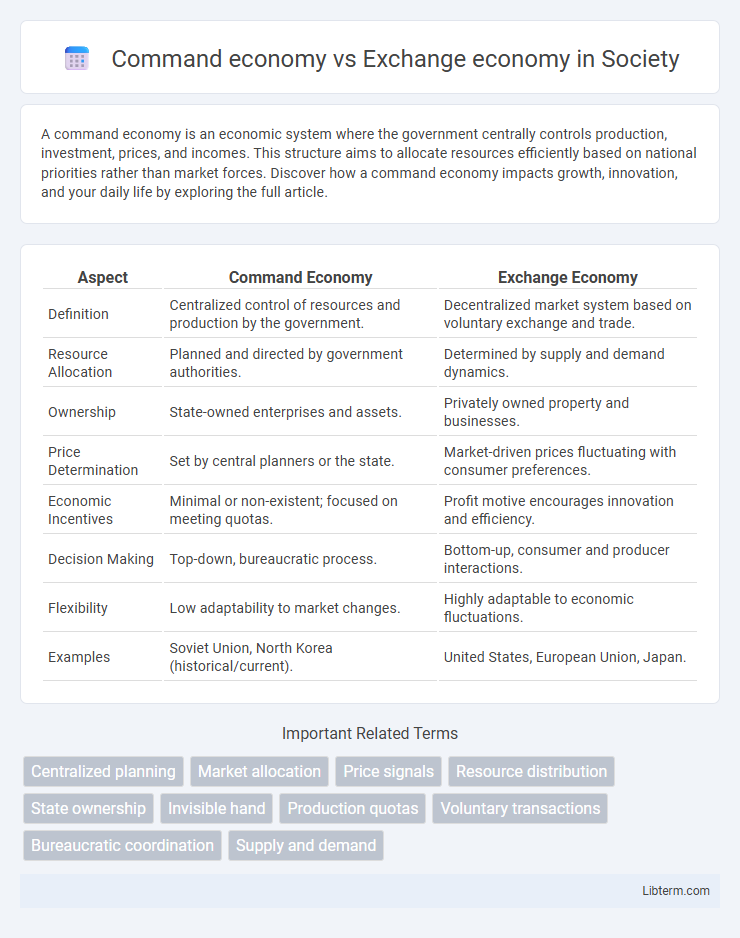A command economy is an economic system where the government centrally controls production, investment, prices, and incomes. This structure aims to allocate resources efficiently based on national priorities rather than market forces. Discover how a command economy impacts growth, innovation, and your daily life by exploring the full article.
Table of Comparison
| Aspect | Command Economy | Exchange Economy |
|---|---|---|
| Definition | Centralized control of resources and production by the government. | Decentralized market system based on voluntary exchange and trade. |
| Resource Allocation | Planned and directed by government authorities. | Determined by supply and demand dynamics. |
| Ownership | State-owned enterprises and assets. | Privately owned property and businesses. |
| Price Determination | Set by central planners or the state. | Market-driven prices fluctuating with consumer preferences. |
| Economic Incentives | Minimal or non-existent; focused on meeting quotas. | Profit motive encourages innovation and efficiency. |
| Decision Making | Top-down, bureaucratic process. | Bottom-up, consumer and producer interactions. |
| Flexibility | Low adaptability to market changes. | Highly adaptable to economic fluctuations. |
| Examples | Soviet Union, North Korea (historical/current). | United States, European Union, Japan. |
Introduction to Economic Systems
A command economy is characterized by centralized government control over resource allocation, production, and distribution decisions, prioritizing planned economic activities to meet societal goals. In contrast, an exchange economy emphasizes decentralized market mechanisms where individual producers and consumers interact freely to determine prices and allocate resources through voluntary trade. Understanding these fundamental economic systems highlights the variation in how societies organize production and distribute goods, impacting efficiency and resource utilization.
Defining Command Economy
A command economy is an economic system where the government centrally plans and controls production, distribution, and pricing of goods and services, eliminating market competition. This centralized approach contrasts with an exchange economy, which relies on voluntary trade and market forces to allocate resources efficiently. In a command economy, resource allocation decisions are made by state planners rather than individual consumers and producers.
Defining Exchange Economy
An exchange economy is a system where individuals or entities trade goods and services based on supply and demand without central planning, allowing market forces to determine prices and resource allocation. Unlike a command economy, which relies on government directives to control production and distribution, an exchange economy emphasizes voluntary transactions and decentralized decision-making. This economic model fosters competition, efficiency, and innovation by enabling participants to respond freely to changing market conditions.
Historical Background of Both Systems
Command economies originated prominently in the 20th century, exemplified by the Soviet Union and Maoist China, where centralized governments controlled production and resource allocation to achieve rapid industrialization and social goals. Exchange economies have roots dating back to ancient trade systems, evolving through market economies where decentralized transactions, driven by supply and demand, shaped economic activities in classical Greece, the Roman Empire, and later capitalist societies. These historical contexts highlight how command economies prioritize state control, whereas exchange economies emphasize individual market interactions and voluntary trade.
Key Characteristics: Command vs Exchange
A command economy is characterized by centralized government control over production, allocation, and pricing of goods and services, eliminating private ownership and market competition. In contrast, an exchange economy relies on decentralized market forces, where supply and demand dictate prices and resource distribution through voluntary transactions. Key distinctions include the command economy's emphasis on planned resource management versus the exchange economy's reliance on individual choice and price mechanisms.
Government Role and Control
In a command economy, the government exercises extensive control over production, allocation, and pricing decisions, centralizing economic planning to meet national objectives. Conversely, an exchange economy relies on decentralized market mechanisms where the government plays a minimal role, allowing supply and demand to determine resource distribution. Government intervention in a command economy is direct and comprehensive, whereas in an exchange economy, it is limited to regulatory frameworks ensuring market efficiency and fairness.
Resource Allocation Methods
Command economies allocate resources through centralized planning by government authorities determining production quotas, pricing, and distribution based on social objectives. Exchange economies, typically market-based, rely on supply and demand dynamics where individual agents trade goods and services freely, guiding resource allocation efficiently through price mechanisms. These contrasting methods impact economic flexibility, innovation incentives, and responsiveness to consumer preferences.
Economic Efficiency and Productivity
Command economies often struggle with economic efficiency due to centralized decision-making, leading to resource misallocation and reduced productivity. Exchange economies, driven by market signals and voluntary trade, typically promote higher economic efficiency by optimizing resource allocation and incentivizing innovation. The competitive environment in exchange economies fosters productivity growth, whereas command economies may face stagnation due to bureaucratic constraints and lack of market responsiveness.
Real-World Examples and Case Studies
China's command economy, characterized by centralized planning and government control, contrasts sharply with the market-driven exchange economies of countries like the United States. North Korea exemplifies a strict command economy where resource allocation and production decisions are state-controlled, leading to inefficiencies and limited innovation. Conversely, the exchange economy in Hong Kong demonstrates how free-market mechanisms drive rapid economic growth and wealth creation through decentralized decision-making and voluntary trade.
Pros, Cons, and Modern Relevance
A command economy centralizes resource allocation and production decisions through government control, ensuring equitable distribution and stability but often leading to inefficiencies and lack of innovation. In contrast, an exchange economy relies on market-driven supply and demand, promoting competition and consumer choice while risking inequality and market failures. Modern relevance sees hybrid systems combining state regulation with market mechanisms to balance economic growth, social welfare, and innovation in diverse global contexts.
Command economy Infographic

 libterm.com
libterm.com